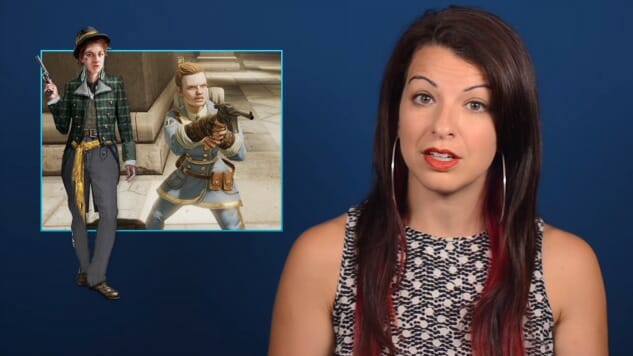Watch: Feminist Frequency Takes on the Argument That “Women are Too Hard to Animate”
Images via Feminist Frequency/YouTube Games Video Feminist Frequency
“Are Women Too Hard To Animate?” is the latest episode in Feminist Frequency and Anita Sarkeesian’s Tropes vs. Women in Video Games series. Sarkeesian begins this episode by retelling how, at E3 2014, Ubisoft said they did not include playable female characters in Assassin’s Creed: Unity because it would mean “double the animations, double the voices, and double the visual assets” and would require 8,000 new animations.
These statements sparked a backlash on Twitter, with both fans and other game developers calling out Ubisoft for what the subtext they saw as “We don’t really care to put the effort in to make a woman assassin.” Jonathan Cooper, an animator who worked on previous Assassin’s Creed games even came out and said “I would estimate this to be a day or two’s work. Not a replacement of 8,000 animations.”
Sarkeesian connects this incident to the broader exclusion of women from games:
Of course, Ubisoft weren’t and aren’t the only ones with this apathetic attitude toward female inclusion. In fact, not doing the necessary work to include women has long been the norm in the video game industry. The FIFA soccer game series, which had its first entry in 1993, took over 20 years before finally introducing female teams in FIFA 16. And it took ten years for Call of Duty to introduce female soldiers into its competitive multiplayer with 2013’s Call of Duty: Ghosts. The long-running Battlefield franchise, on the other hand, has still never allowed for playable female characters in its multiplayer modes.
Sarkeesian goes on to point out that when women are represented as combatants in games they are often objectified and sexualized, such as in Metal Gear Solid IV and Hitman: Absolution, adding “an air of gendered violence” to the player’s interactions with them. Sarkeesian praises games such as Assassin’s Creed: Syndicate and Bioshock Infinite for including female combatants and enemies without fanfare or sexualization.
Sarkeesian finally addresses the oft-cited and absurd counterargument that including women combatants is unbelievable or historically inaccurate:
There is still a tendency for game studios to treat female representation as some kind of extravagant goal, rather than simply treating it as standard in the same way they handle male representation. The excuse that I hear most often for the absence of female combatants in games is that players wouldn’t believe it. But games, even ones that draw on historical locations or events like the Assassin’s Creed series, create their own worlds and set the tone for what we will or won’t believe. To participate in the worlds games create, we happily accept time travel, superpowers, ancient alien civilizations, the ability to carry infinite items, the idea that eating a hot dog can instantly heal your wounds, and a million other fictions. It’s certainly not too much to ask that these fictional worlds give us believable female combatants too.
Games determine what is believable within their worlds through how they present things. When “female combatants are presented as straightforward, normal and believable,” Sarkeesian says, “players have no problem believing it. And they shouldn’t, since, unlike those magical healing hot dogs I mentioned, female combatants actually exist.”